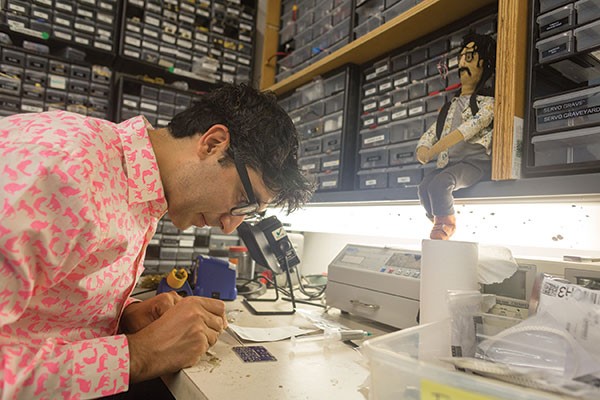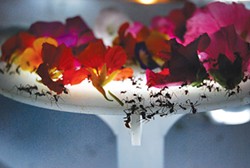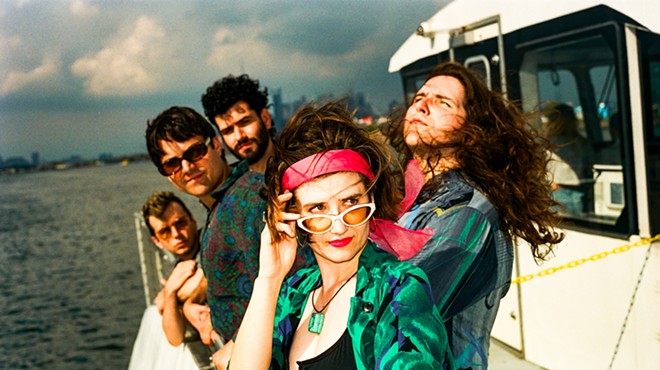The odd ant farm aside, most people don’t think of ants as pets. Ditto bees: Apiarists want honey, not cuddles. And even less so for mosquitoes, which in the age of Zika, West Nile and mass malaria might be earth’s most despised creatures.
Yet ants, bees and mosquitoes are among the animals that artist Ali Momeni is drawn to — and which he thinks his work can persuade wary humans to appreciate just a bit more.
Momeni, 40, is an associate professor in Carnegie Mellon University’s School of Art. He belongs to a new wave of artists whose work blurs the line between traditional art and scientific inquiry. His works, often collaborations with researchers or other artists, have been shown from New Dehli to Minneapolis, and have received international press attention: He was recently quoted in a Newsweek article about computers making art, for instance, and the BBC covered the Glasgow, Scotland, premiere of Truce, his mosquito-based installation with regular collaborator Robin Meier, an artist based in Paris.
Momeni ranges widely across art, science and technology; high-profile projects include Dranimate, software that lets users turn still images into animations using hand gestures. But some of Momeni’s most striking work has revolved around little-loved critters with six (or eight) legs.
Truce, for instance, was based on a paper Momeni (then working at the University of Minnesota) saw in a scientific journal: Mosquitoes in flight listen to other mosquitoes and then harmonize the pitch of their buzzing wings. For Truce (exhibited in Japan and Paris), Momeni and Meier found a way to harmlessly tether single mosquitoes to a wire and then expose them to the buzz of a “ghost” female mosquito whose pitch rose and fell. With the harmonic addition of a synthesized human voice, the whole thing became “kind of a machine-mosquito love song,” says Momeni. Close-up cameras allowed gallery visitors to watch.
The Tragedy of the Commons, also created with Meier, was a large-scale installation incorporating a colony of South American leaf-cutter ants — a “dynamic playground” where the ants could forage for food while navigating obstacles like a spring-loaded drawbridge. The work, which premiered in Paris in 2011, let visitors (with the help of surveillance cameras and microphones) see and hear for themselves how thousands of ants function as a “superorganism,” or a single entity dedicated to the survival of the colony and its queen.
Here in Pittsburgh, Momeni curated All Around Us, an insect-themed exhibit at Wood Street Galleries. The show — which was covered in The Scientist, an Ontario, Canada-based magazine for life-sciences professionals — featured work by artists from around the world. Pieces included: a robot operated by Madagascar hissing cockroaches; an exhibit of live crickets; and Momeni’s own “Observation Hives,” which consisted partly of two beehives encased in clear Plexiglass to make the hive visible, with transparent tubes leading out the Downtown gallery’s fourth-floor windows so visitors could watch bees departing to gather pollen.
Momeni’s goal is to get people to see bugs anew, not just as picnic-time nuisances. “These pieces are all about setting up a very human context around these insects,” he says. In Truce (whose very title urges a human-mosquito détente), visitors “can finally stand next to a mosquito and watch it closely.” In Tragedy of the Commons, audiences can observe ants and “appreciate their talents and learn about their superpowers.”
Momeni says his insect-themed shows generate positive feedback from visitors: “They tend to leave with a different experience than they’ve ever had with these organisms that we tend to ignore.”
Murray Horne, curator of Wood Street Galleries, says that visitors to All Around Us were indeed fascinated, especially by “Observation Hives.” At first, Horne says, “Everyone says, ‘It’s a bee! It’s a bee!’” But ultimately, each hive is “a whole ecosystem which is completely independent of ours, and in fact, people would relate to it.” He quips, “The bees were the honey for everything else in the show.”
“People spent sometimes an hour just sitting next to the beehive,” says Momeni. He believes visitors began to grasp that all the bees have different tasks, even different personalities. With ants, he says, it’s even easier to see human analogues: In an ant colony, you can witness activities ranging from the mundane, like garbage disposal, to the complex, like social shunning, altruism and even martyrdom (individuals sacrificing themselves for the good of the group). Leaf-cutter ants even carry off their dead, albeit to use the corpses as fertilizer for the fungus they grow as food.
While visitors to such exhibits might not develop the kinds of emotional bonds with insects that we do with conventional pets, researchers and other caretakers Momeni works with often do. “There’s a real kinship between the scientists and these organisms,” he says. The caretakers feed and breed their wee charges, after all. Ant queens, and hence their colonies, can live longer than most dogs, up to 20 years, Momeni says. “They can sometimes outlive generations of lab assistants,” he adds. “People really stress out about them if the conditions [for their well-being] aren’t right.”
Even actual petting happens. At the opening reception for All Around Us, Horne watched Canadian researcher Garnet Hertz handle the Madagascar hissing cockroaches that pilot his small robots. (A roach is harnessed in, and light cues prompt it to “run” on a plastic ball that guides the machine around the gallery, effectively substituting a living organism for the computer.) Though audiences were “grossed out,” Horne says, Hertz calmly set an inch-and-a-half-long roach on his hand and stroked its back — as Horne puts it, “a little cockroach massage!”
As far as insects might be from your idea of house pets — they’re the very creatures we want out of the house — Momeni believes his projects can also inspire discussion about domesticated animals. He has an unusual cultural perspective on the issue: Though he’s lived in the West for decades, Momeni was raised in Iran, and despite his affection for animals, he often finds Americans’ relationships with their pets bizarre.
In the 1980s, when Momeni was growing up, there were pet cats, and his family had a golden retriever named Jimmy (long story). So he understands the appeal of what he calls “our furry, leashed animal friends.” But those cats were really neighborhood cats: Everybody fed them, and they never came indoors. Even Jimmy stayed outdoors. So Momeni doesn’t understand stuff like American pets sleeping with their owners, or people shelling out “$6,000 for an endoscopy for a cat.”
“It’s totally insane to me that we’ve come that far, to investing more in a cat than in a less fortunate human being in your community,” he says.
On the other hand, Momeni acknowledges he has learned that this issue is “really not something you can discuss with pet-owners.”
Instead, he merely notes that, for their part, ants both vastly outnumber humans and will likely outlast us on Earth. That’s worth considering in terms of The Tragedy of the Commons, which is named for philosopher Garrett Hardin’s famous 1968 essay theorizing that, among humans, individual interests make impossible the sharing of free common resources (like pastureland and ocean fisheries). Yet while the ants in the installation share a common resource, too — the food their keepers supply — their collective behavior allows them to share it effectively. So maybe there’s something we can learn from ants after all.
















